2 July 2017. Our flight from Lima descended through scattered towers of tropical cumulus clouds to the airport at Iquitos. Luckily our luggage made it, and we careened through the crazy streets in one of the ubiquitous “mototaxis” – tricycle contraptions with a semi-enclosed back bench-seat behind the driver, built around Toyota motorbikes – to a small hotel in the city center, the Victoria Regia. I was in Amazonia at last!
Amazing Amazonia. The Amazon River is the largest river on our planet, carrying about one-fifth of all the freshwater flowing into the oceans. Its watershed is the largest river basin in the world, covering 40 percent of South America. Calculations by Brazilian geographers show that the Amazon the longest river in the world, a distance of more than 4,400 miles from its headwaters in central Peru to the Atlantic (although some geographers still claim the Nile is longer). Twelve Amazon tributaries are each around a thousand miles long. And occupying this giant river basin is the largest tropical rainforest on Earth. Around one-third of all of Earth’s species live here.
My first trip to Amazonia was part of the information-gathering process for a final evaluation of the Peru Forest Sector Initiative (PFSI), which I was conducting for the U.S. Forest Service’s Office of International Programs. The program, PFSI for short, began in 2009 under interesting and somewhat complicated circumstances. A bilateral free-trade agreement between the U.S. and Peru entered into force in February 2009, and it had something called the “Forest Governance Annex.” This annex, included at the last minute under pressure from U.S.-based international environmental organizations, required Peru to undertake a long list of reforms of its forest sector, many aimed specifically at curbing the illegal trade in species of high-value tropical hardwoods such as mahogany that are listed under the Convention on International Trade in Endangered Species (CITES). The U.S. Forest Service was enlisted to provide technical advice and support to the Government of Peru to comply with this annex to the trade agreement, and the PFSI program was born. My task in the evaluation was to try to determine whether, after eight years of work and investment, the program had been successful or not. My colleague on the evaluation team was the monitoring and evaluation specialist of PFSI, Maria Paz Montoya.
Over the next few days we travelled around Iquitos from meeting to meeting on the noisy mototaxis, trying to understand how PFSI’s activities had helped the regional government of Loreto, this huge Amazonian region of northeastern Peru, improve the management of its vast forests and in the process comply with the requirements of the U.S.-Peru Trade Promotion Agreement. We talked to regional government staff who worked on forest management, faculty of the Universidad Nacional de la Amazonía Peruana, foresters from one of the many timber companies based in Iquitos, and staff of non-governmental organizations and research institutes.
One of the most interesting meetings for me was with the Instituto del Bien Común – the “Institute for the Common Good” in English – an NGO based in Iquitos that works with rural communities to develop shared benefits from the rivers, forests, and protected natural areas of communal territories, many of which are occupied by indigenous Amazonian tribes. The director and staff were articulate and on top of the issues. A collection of imaginative paintings by an indigenous Amazonian artist, Darwin Rodriguez Torres, was displayed around their office. The paintings evoked the complex intertwining of ecology and culture that has long fascinated me and which is nowhere more complex than here in Amazonia.
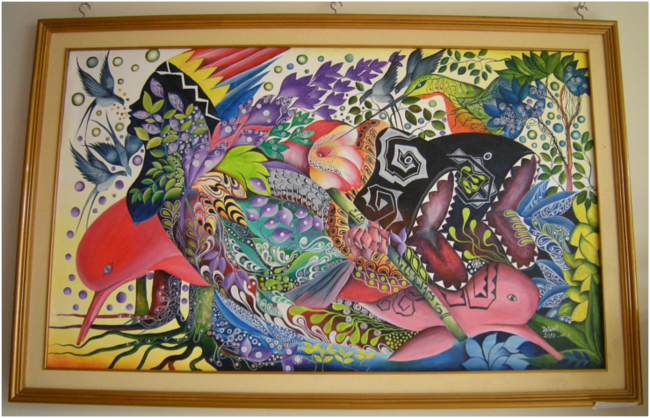
La danza de la yuca dulce (“Dance of the sweet yuca” in English), painting by Darwin Rodriguez Torres. Photo by B. Byers, 4 July 2017
Iquitos, with a population of around half a million, is the largest city in the world unreachable by road; it is serviced only by riverboats and airlines. It is the capital of the region of Loreto, Peru’s largest region, which is about the size of the U.S. state of Montana, covering 29 percent of the country. Iquitos is around 2,200 miles from the mouth of the Amazon – almost exactly half the distance from the river’s source to its mouth – and about 700 miles from Manaus, Brazil, where the huge northern tributary of the Amazon, the Rio Negro, joins the main river.
Iquitos was the capital of the “rubber boom” on the upper Amazon from about 1880 to 1912. Rubber assumed its major role in modern industry after 1845, when the American chemist, Charles Goodyear, and a British chemist both patented the process of “vulcanization,” which made natural rubber less sticky and more durable, and opened up a new realm of industrial applications. Steamboat navigation reached Iquitos in the 1860s, and with growing international demand for rubber, it became a booming commercial and cosmopolitan city. By 1911, rubber accounted for 10 percent of Peru’s annual exports. But the “boom” in exploitation of wild rubber from Amazonia was short-lived. In 1876, the British explorer Henry Wickham took wild rubber seeds from the Amazon to Kew Gardens in London, and from there they were widely propagated in Britain’s colonies in Malaysia and India. By 1912 plantation rubber from Asia outcompeted wild rubber from Amazonia and dominated the world market, and the economy of Iquitos crashed.
One afternoon, with an hour or so free between meetings, I visited the “Museo de Barcos Históricos,” the Historic Riverboats Museum, located on the Iquitos malecón – the riverfront promenade that was so grand in its heyday. The mainstem of the Amazon has shifted several kilometers eastward in the last century, and the city now sits on a backwater bend. The museum is housed in a historic riverboat, the 100-foot-long, steam-powered Ayapua, which was built in 1906 in Hamburg, Germany, and made its way across the Atlantic and up the Amazon to Iquitos during the height of the rubber boom. That period, in the years running up to World War I, was the final frenzy of exploitation of wild-harvested rubber in Amazonia. The Ayapua played a role in gathering the great wealth of bouncy gold that enriched the Iquitos rubber barons; a sign in the onboard museum said that “Every time the Ayapua would sail to the rubber districts for a month, she would return with [rubber worth] $2,000,000 in today’s money in her hull.”
Roger Casement, a British consul, travelled in the Putamayo region of Peru in 1910-1911 and documented the terrible human toll imposed on the region’s indigenous people, who were exploited and enslaved to harvest the wild rubber. “The horrendous atrocities that were unleashed on the Indian people of the Amazon during the height of the rubber boom were like nothing that had been seen since the first days of the Spanish Conquest,” according to anthropologist Wade Davis.
The Ayapua was used in filming the movie Fitzcarraldo, a 1982 German film directed by Werner Herzog, which was based loosely on the story of a real-life Iquitos rubber baron. Every night spent in Iquitos we walked from our hotel to a restaurant on the malecón named Fitzcarraldo, where the wooden figurehead from the bow of the Ayapua stood proudly beneath the bar: a bare-breasted indigenous woman with a giant snake, an anaconda, winding up around her waist. The fresh river fish on the menu, paiche and doncella, were spectacular, rivalling the sea fish of Lima.
Decades before the rubber boom, the Amazon was a magnet for geographical and biological exploration. I was reminded of that at the Museo de Barcos Históricos by their display of original editions of books by Alfred Russel Wallace and Henry Walter Bates. Bates’s book, The Naturalist on the River Amazons, was published in 1863 by John Murray in London, and Wallace’s book, A Narrative of Travels on the Amazon and Rio Negro, was published in 1870 by Macmillan in London. Bates and Wallace began exploring the rainforests of Amazonia together in 1848. Wallace returned to England in 1852, but lost his collections of plant and animal specimens when his ship caught fire. He then went eastward to Malaysia and Indonesia, where his research led him to discover the process of the evolution of species through natural selection independently of Charles Darwin.

Title page of the original 1870 edition of Wallace’s A Narrative of Travels on the Amazon and Rio Negro, Museo de Barcos Históricos, Iquitos
Even earlier, in 1800, the pioneering German geographer Alexander von Humboldt and his travelling companion Aimé Bonpland, a French botanist, had explored the Casiquiare canal in Venezuela, an aquatic pass between the Orinoco River and the upper Amazon. Bonpland was one of the first European botanists to collect and describe the giant water lily Victoria regia, with its floating lilypads 10 feet in diameter, whose scientific name commemorates Queen Victoria. On the last international journey of his life in 1911, John Muir made a special effort to see this species near Manaus, but was unsuccessful. Our hotel in Iquitos, the Victoria Regia, was named after this species, and I relished these historical echoes.
In my view of things, human cultural diversity is a part of biological diversity. The relatively isolated human cultures of Amazonia are a rich treasury of knowledge about this topic. For a glimpse, I can recommend the book One River by anthropologist Wade Davis, a joint biography of his ethnobotanist mentor Richard Evans Shultes and autobiography of his own work on the use of hallucinogenic plants by Amazonian indigenous peoples. And there is the 2015 film, Embrace of the Serpent (Abrazo del Serpiente in Spanish), by Colombian filmmaker Ciro Guerra, based on the ethnographical explorations of Karl Friedrich Philipp von Martius, a German botanist who explored the Amazon from 1817 to 1820, and Shultes. And then there is the mind-stretching ethnography of the Pirahã, an Amazonian tribe, by ethnolinguist Daniel Everett, Don’t Sleep,There are Snakes.
——-
After a few days in Iquitos, we mototaxied to the airport and flew to Pucallpa, the capital of Ucayali, another of Peru’s five Amazonian regions. We first flew south over the Amazon River, then over an ocean of lowland forest cut by small snaking tributaries. There were no visible roads and only occasional clearings that marked the presence of people. Pucallpa is situated on the western bank of the Ucayali River, a major tributary of the Amazon. After we landed and got our luggage, we immediately jumped into a full schedule of interviews, again trying to evaluate how the PFSI project had assisted this region in managing its forests.
During a break between meetings in Pucallpa I wandered a dozen sweaty blocks from our hotel to the riverside market that sprawls along half a kilometer of the Río Ucayali near the city center. There could not have been a better place to get an instant summary and synthesis of the riverine economy of the city. A steady stream of big narrow cargo canoes pulled up to the steep muddy shoreline to unload. Plantains, a starchy staple, were among the main goods, along with a colorful spectrum of other fruits.
——-
So what did we conclude about the effectiveness of the Peru Forest Sector Initiative, after all of these interviews and adventures? The PFSI program made very significant contributions to some major reforms of the Peruvian forest sector. Among those are its support for the 2011 Forest Law and Regulations, the institutionalization of a National Forest Inventory, its assistance to regional environmental management, and development of a prototype for a chain-of-custody timber-tracking system to combat illegal logging. For me, one of the most significant findings was that PFSI planted the seed for a vision of modern multiple-use forest management in Peru. That seed was first planted when a U.S. Forest Service staff member gave a short training course on forest planning to Peruvian government forest agency staff. When he asked them how they dealt with the issue of wildlife in forest planning, they had no answer. Trained as foresters, they saw forests only as trees. With that seemingly simple question, he brought to Peru a question that Aldo Leopold had asked early in his career in the U.S. Forest Service, beginning around 1915, and opened their minds to the idea that forests are much more than trees. Forests are also wildlife habitat, watersheds, reservoirs of stored carbon, beautiful landscapes for tourism, and much more.
And what challenges to good forest management in Peru remain? Controlling the illegal harvesting of high-value species like mahogany is still a challenge. This problem, at the heart of the Forest Governance Annex, still has not been solved, although the timber-tracking system whose development was started by PFSI is finally being field-tested. A larger, looming challenge is how to allocate and balance forest uses in this contested, “frontier” landscape. How much of the Amazonian forest should be for protection of indigenous communities, their rights, and the future of their cultures? What about for protected areas for biodiversity and tourism? Clearing for settlement and agriculture? Oil and gas development? Timber production? Natural forest areas set aside to store carbon to slow and prevent climate change caused by global fossil fuel use? Wrestling with those sometimes competing and sometimes complementary land uses will require much work and many hard decisions over the next few decades.
Back in Lima, we travelled the car-choked streets to final meetings with people who had played key roles in the Peruvian forest sector and interacted with the Peru Forest Sector Initiative over its eight-year lifespan. On this cool, grey coast, between days of interviews, I dreamed of rivers winding like serpents through unbroken forest, and in those rivers, pink river dolphins leaping and diving.
For related stories see:
Sources and related links:
- Instituto del Bien Común
- Museo de Barcos Históricos, Iquitos
- Fitzcarraldo
- Fitzcarraldo Restaurant, Iquitos
- Victoria regia
- One River. Wade Davis. 1996. New York: Simon and Schuster.
- Embrace of the Serpent
- Don’t Sleep, There Are Snakes. Daniel L. Everett. 2008. New York: Random House.
- Don’t Sleep, There are Snakes. Background by Daniel Everett.

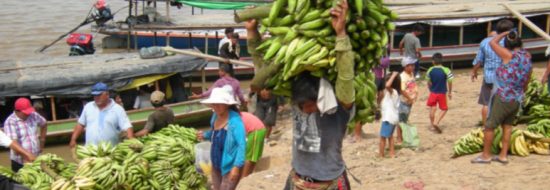
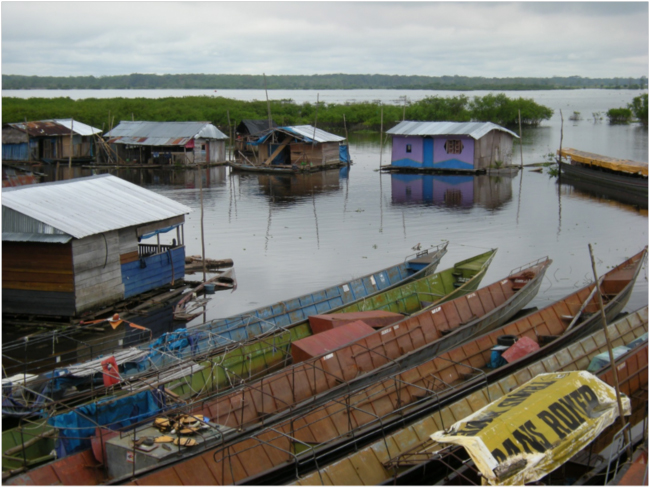
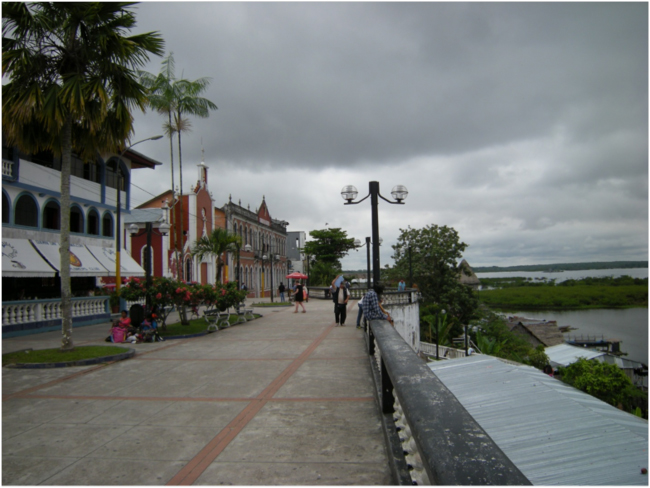
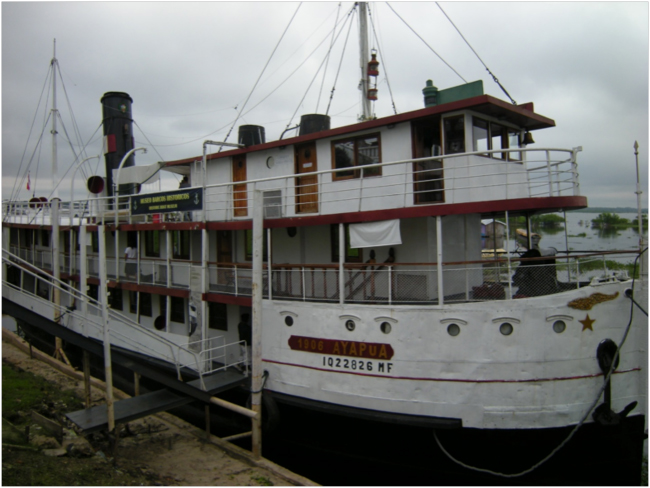

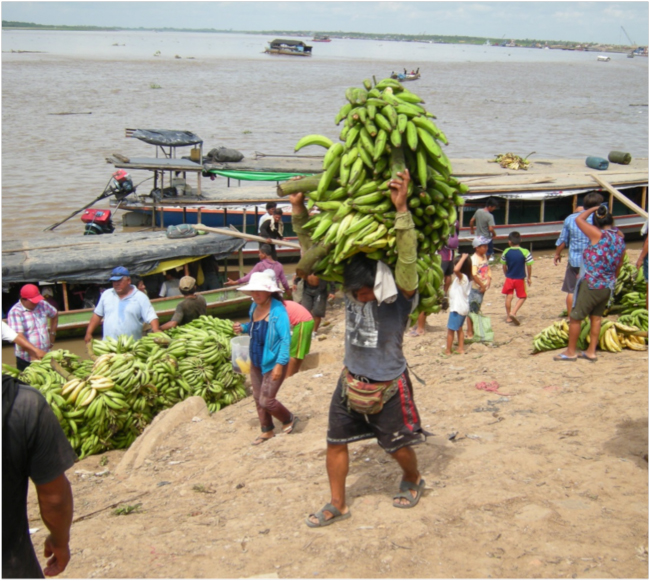
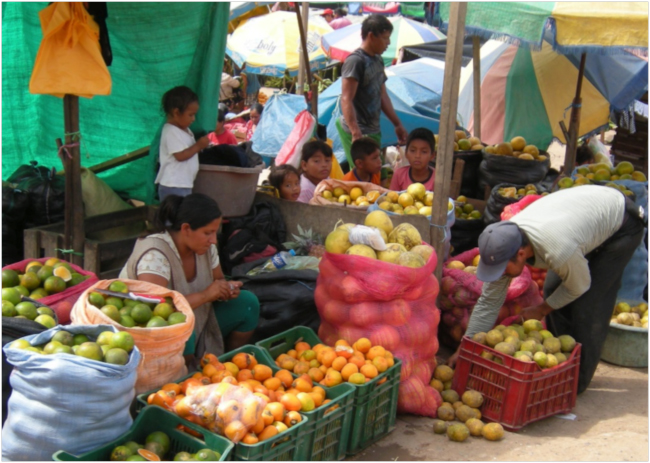
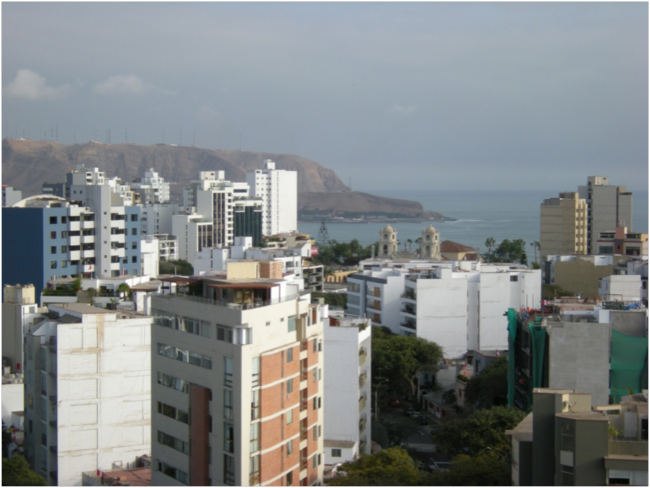



December 6, 2017 6:41 pm
I tried to thank you for this beautiful “essay” a couple of days ago, but AOL has not always been my friend. Not sure it got through…or whether this will!
All the best!
Dave Armstrong (and Susan Jessup)
December 7, 2017 3:46 pm
Thank you for the positive feedback, Dave! Got it!
Bruce